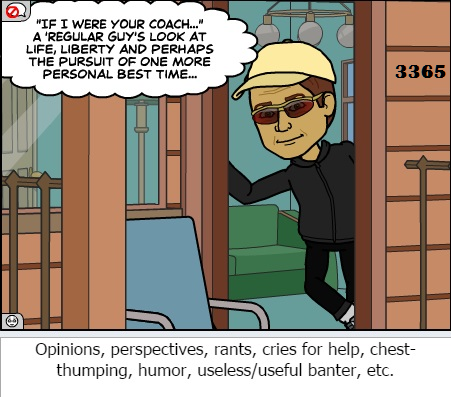 "There is a certain relief in change, even though it be from bad to worse! As I have often found in traveling...that it is often a comfort to shift one's position, and be bruised in a new place." - Washington Irving
"There is a certain relief in change, even though it be from bad to worse! As I have often found in traveling...that it is often a comfort to shift one's position, and be bruised in a new place." - Washington IrvingThe season has begun to change, and just in the nick of time for this ol' coach/runner. Tampa winters, all 14 of them, I could tolerate; there might (or might not!) be a week of nasty cold weather around the turn of the year, and February could have its moments here and there. But February is a short month and we could always look with longing to nice conditions in March.
Pensacola, on the other hand, has been a completely different story. How could a city which was more northerly be more hot, more humid and more...well...blah, during the summer? And, to top that all off, predictable in its climatic unpredictability in those months which possess an "R"?
It has been nice to get back on the streets, even if it's for twenty minutes at a time right now. I did go for a sixty-minute walk yesterday morning while my wife ran on the same course. I marveled at the blooms and buds, shoots and flowers which began to make their presence known as I strolled past some of the front yards in the neighborhood just a half mile from my home. It began to make me think life was going to be all right.
Then, I remembered it was the last days of February. March was not far behind.
March, here in the "Redneck Riviera," does not enter or depart like either a lion or a lamb. It's like a - lab - as in labrador retreiver. Smart enough to figure out how you're going to react, friendly enough while you're around, but if you fail to keep an eye on them then say farewell to those really nice shoes you just got on sale. March here doesn't go in one way and out in another...it comes in, makes a mess, then asks you (while you're comfortable in front of the tube)to let it back out. Ah, but we love it and wouldn't want it any other way. Especially the weekend around St. Patrick's Day, when we have the largest 5,000-meter prediction run in the country.
My wife and I went to brunch the other morning, after our morning efforts, with one of our closest friends, Charley and Sheila. We marveled at the conditions and wondered whether they would persist until the first week of May, when our summertime conditions show in full force. I then said, "Don't get too excited about this nice weather, because you know it's all going to hit the fan during the weekend of McGuire's. It will either be fantastic on the day and horrible immediately after, or it will be really nasty cold." Charley then laughed at the fact I would remember years past and the temperature tendencies; 80 degrees one day, 35 the next.
Forecast schizophrenia.
To plan for the McGuire's 5K, we pull out the racing attire we want to wear, the stuff we were forced to wear at the '07 Crescent City Classic, and then the oldest running gear we have, on which we won't mind having nasty green beer poured or spilled by someone else. Place all those items in a laundry basket (or "the bag" I wrote about a couple of weeks ago), shake them up and pluck out the first items which keep us from being busted for indecent exposure.
But getting back to the blooms, the weather and all...I started to think about what was going to happen to those pretty buds, blossoms and flowers which were starting to spring and would be meteorologically-blindsided by the middle of the month. They probably reacted to something in nature in the way plants react when everything seems to be all right. I looked at each of those gorgeous blooming trees and all I could think was: 'you fool, you fool...'
Those trees and I had a lot in common last Monday morning, after I did 4.5 miles, the first lick of running after three weeks without a step. Everything reverted back to something like normal. And then, reality set in around Tuesday evening. That chunk of running was a shock to my system, one which left me hobbling for the remainder of the week. Not only were there muscles I hadn't offended in a long time which were now very upset at me, but they took their cues from the unhappy people in Egypt; if protest could topple a 40-year rule, it certainly could hobble a (nearly) 50-year-old man. Every step going down stairwells at work caused my legs to fire uncontrollably. There were moments where my leg buckled as I was teaching my seminar late in the week. I hadn't felt this bad since my marathon walk-of-shame in 2007.
I had, as the Irving quote above suggests, felt the relief of change; the transition from sidelined runner to slow runner. Naturally, the bruises and discomfort had come, not so much in new places, but in places common to new runners. Nothing that time, patience, self-massage, hydration and non-steroidal anti-inflammatories could not alleviate.
Ah, the ache of being a born-again runner.











